Tobacco Nation: The deadly state of smoking disparity in the U.S.
Smoking in the U.S. has dramatically declined in the last two decades, particularly among the country’s youngest residents. In 2000, 23 percent of teens smoked cigarettes. By 2016, the number had fallen to just 6 percent. While there is much to celebrate in the reduction, the average national rate hides a significant variation found within the country.
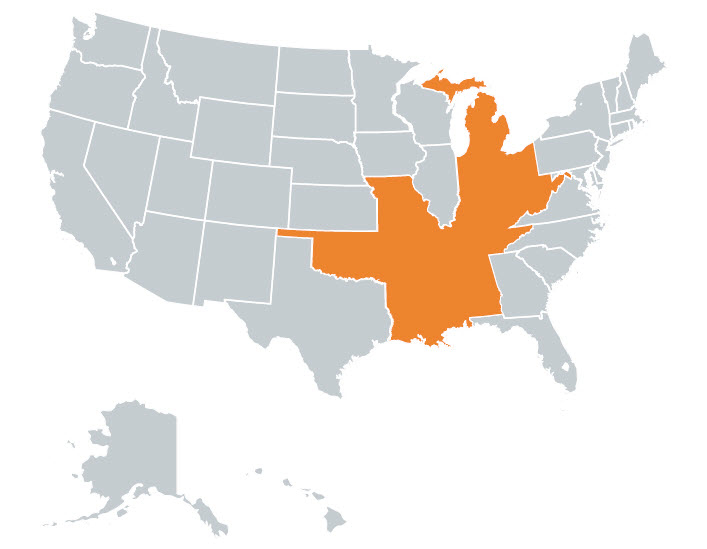
A collection of 12 contiguous states stretching from the upper Midwest to the South undermines this national achievement. In the region of the country we’ve termed “Tobacco Nation,” smoking prevalence exceeds not only the national average, but that of many of the most tobacco-dependent countries in the world.
Residents of this region are less well-off financially than those in the rest of the U.S., and consequently spend a higher percentage of their disposable income on harm-causing tobacco. Health outcomes in Tobacco Nation are also relatively poor and access to care is more limited than in other parts of the country. Further compounding the problem is the relative lack of smoke-free laws and other tobacco-control policies designed to protect the public and encourage cessation. It should be no surprise that one of the major international tobacco companies recently declared the U.S. “an exciting opportunity for long-term growth.”
The overall picture that emerges is one of a significant portion of the U.S. that appears to have troubling similarities to less well-developed countries, which lack the income, infrastructure and health care resources to provide aid and support to their residents. Simply put, Tobacco Nation is a country within a country. And it is in trouble. The U.S. is already well below its high-income peers when it comes to life expectancy, ranking just 43rd among countries around the world, according to the World Health Organization (WHO). Reducing these disparities will require a serious effort that starts with reducing tobacco use.

Location and Demographics
Tobacco Nation is comprised of 12 states with the highest adult smoking prevalence: Alabama, Arkansas, Indiana, Kentucky, Louisiana, Michigan, Mississippi, Missouri, Ohio, Oklahoma, Tennessee and West Virginia. With more than 66 million residents, these states include roughly 20 percent of the U.S. population. As in other parts of the U.S., these states have slightly more females (51 percent) than males (49 percent) and over 20 percent of its residents are young people (aged 10-24).
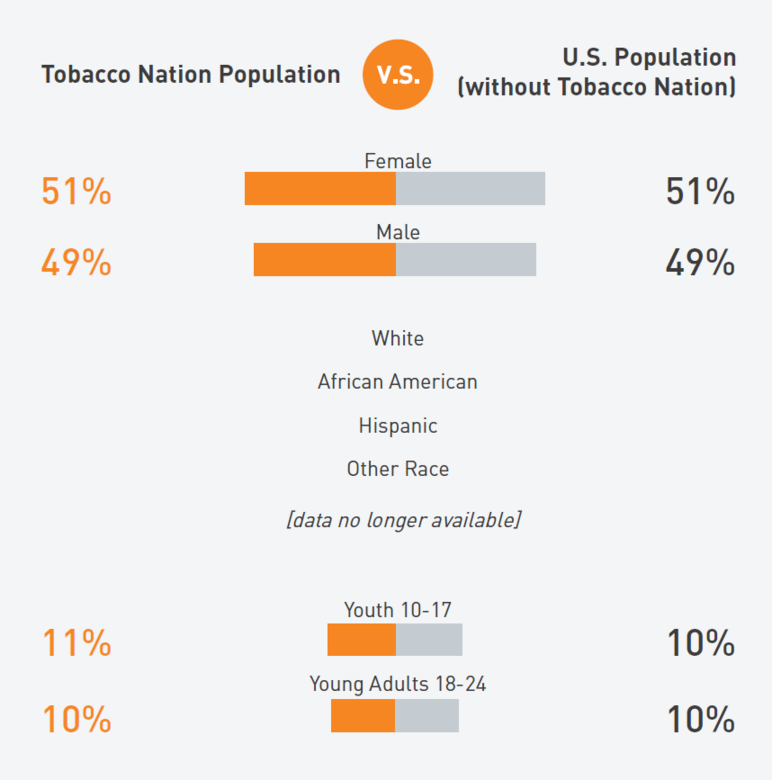
Tobacco Nation is also not as well-off financially. On average, individuals living in Tobacco Nation earn nearly 21 percent less per year ($45,133) than the average resident within the rest of the U.S. ($56,852) (p < 0.001). In addition, 17 percent of its population lives below the poverty line of $24,600 per year for a family of four, compared to 15 percent of the rest of the U.S. population. Tobacco Nation provides evidence that the tobacco epidemic disproportionately burdens those least financially able to afford it. The population of this region is also less educated than the rest of the U.S. Only 22 percent of residents hold a college degree or higher, compared to 28 percent of the population in the other 38 states.
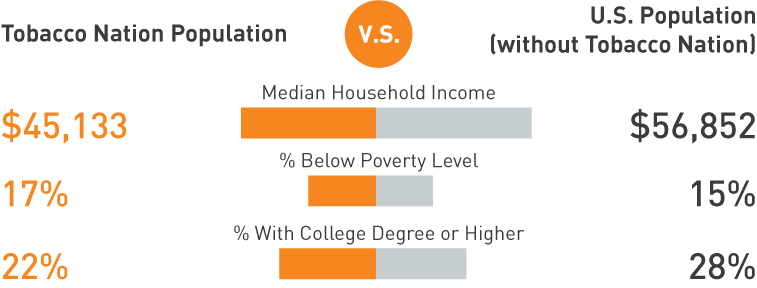
Residents of Tobacco Nation are slightly less likely to be engaged in the labor force (61 percent versus 64 percent of the rest of the U.S.) and are more likely to work in industries like manufacturing (14 percent versus 9 percent). They are also less likely to work in a professional, scientific or management position (9 percent) than the rest of the U.S. average (12 percent).
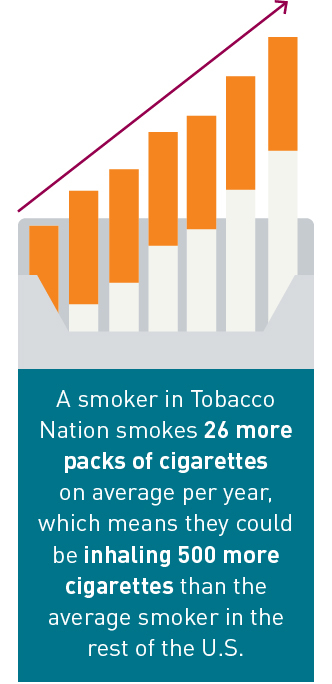
Smoking Prevalence
Adults (18 years of age and older) in Tobacco Nation are more likely to smoke than the average U.S. adult. Twenty-two percent of Tobacco Nation’s adults smoke, compared to 15 percent of adults in the rest of the U.S. The region’s youth also smoke at higher rates compared to the average U.S. youth aged 12-17 residing in one of the other 38 states (12 percent versus 9 percent).
Not only do Tobacco Nation’s youth and adults smoke at higher rates, their residents also smoke many more cigarettes per capita annually (66.6 packs) than those in the rest of the U.S. (40.6 packs). In practice, this could mean that over a given year, a person living in Tobacco Nation could be inhaling 500 more cigarettes than the average smoker in the rest of the U.S.—an addiction with serious consequences.
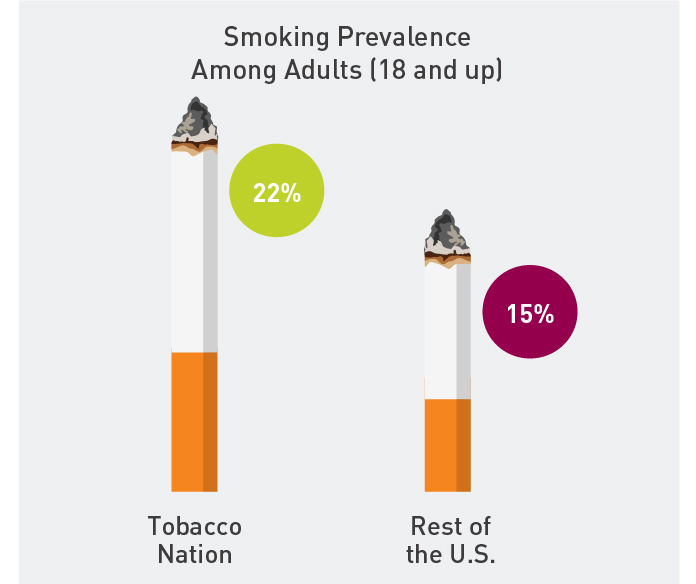
Mortality and Disease
Health Incidence and Life Expectancy
We know that residents of Tobacco Nation smoke far more cigarettes than their neighbors, so what does that mean with regard to their health? The numbers show us that where tobacco use is high, tobacco-related health conditions and diseases are high too. Given the number and frequency of cigarettes smoked, it is both dismaying and perhaps unsurprising that lung and other cancer incidence, heart disease and chronic lower respiratory disease mortality are higher across Tobacco Nation than in the rest of the U.S. As of 2014, Tobacco Nation residents were also more likely to be uninsured (11 percent) compared to the average U.S. resident within the other 38 states (10 percent).
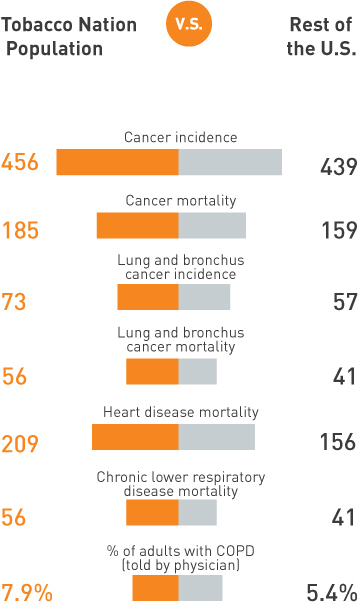
Life expectancy rates across geographic areas are highly correlated with preventable health behaviors such as smoking. In cities with highly-educated populations, high incomes and high levels of government spending, the poor live longer and have healthier behaviors. In New York City, for example, where government support is relatively high and public policies encourage better health for all, its poorest residents fare better than similar residents living in other parts of the country. Conversely, in areas with high rates of smoking and low levels of government spending, the poor have the shortest life expectancy. In these areas, the deck is stacked against them. This adds up to a stark reality for residents of Tobacco Nation who are in areas of the greatest smoking prevalence and typically have low levels of government spending. On average, Tobacco Nation residents live shorter lives and face a higher risk of dying than other Americans. Average life expectancy in Tobacco Nation is 76.6 years, compared to 79.3 years in the rest of the U.S. Tobacco Nation residents are more likely to die from cancer than those in the rest of the U.S. Not only does smoking raise the risk of lung and bronchus cancer, it also raises the risk of developing heart disease.
Here again, Tobacco Nation exceeds the national average; moreover, eight of America’s least heart-healthy states are a part of Tobacco Nation. In fact, when Tobacco Nation is removed from the U.S. average, the comparison is even more stark: Tobacco Nation residents’ heart disease mortality is 25 percent higher than that of the remaining 38 states
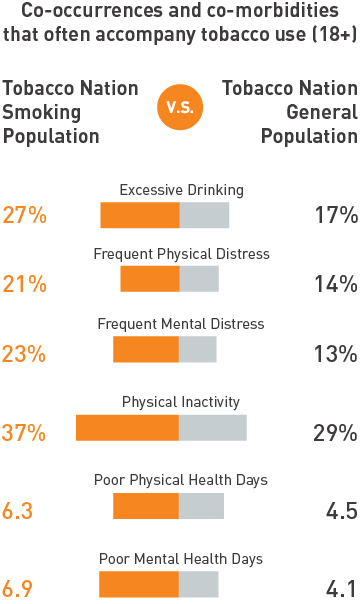
Co-occurrences and Co-morbidities
Compounding the poor tobacco-related health outcomes are the co-occurrences and co-morbidities that often accompany tobacco use. Among the total population of Tobacco Nation, 17 percent of its residents report excessive drinking, compared to 27 percent of smokers, a whopping 10 percent jump when alcohol consumption co-occurs with smoking. Tobacco Nation’s smokers are also more likely to report frequent mental distress (23 percent) than the average Tobacco Nation resident (13 percent). Similarly, smokers in Tobacco Nation report much higher rates of frequent physical distress (21 percent) than the general population of Tobacco Nation (14 percent). It is also important to note that Tobacco Nation as a whole fares poorly in mental and physical markers of well-being, compared to the rest of the nation. As a whole, Tobacco Nation residents suffer more mental and physical distress than the average U.S. resident.
These factors, along with an overall higher rate of physical inactivity in Tobacco Nation compared to the rest of the U.S., affect not just its residents’ health, but potentially their livelihood. It is even worse when comparing the rates of physical inactivity among Tobacco Nation’s entire population (29 percent) to Tobacco Nation’s smoking population (37 percent). In Tobacco Nation, where almost a quarter (22 percent) of its working residents are in physically-demanding industries, like manufacturing, construction and agriculture, physical and mental health are especially critical to gain and maintain employment.
Yet Tobacco Nation residents report more than 10 percent more “poor” physical- and mental-health days than the average American. And Tobacco Nation smokers report substantially more (29 percent) poor physical days, and 40 percent more poor mental days than their average non-smoking neighbor. Crucially, the loss of a job could also mean the loss of health insurance. And in Tobacco Nation, health care is already limited.
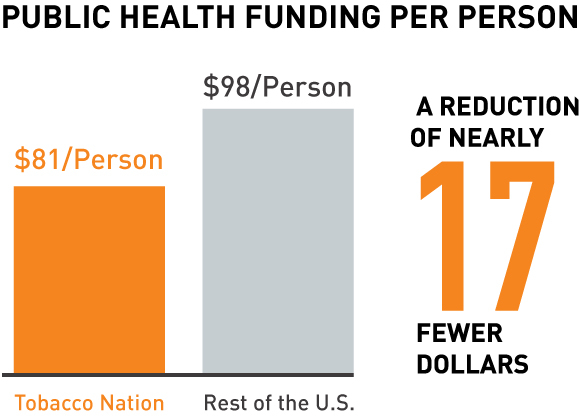
Health Care Access
The U.S. has notably fallen short in providing timely and accessible health care when compared to other high-income countries. Tobacco Nation is in an even more dire situation. Compared to the rest of the nation, Tobacco Nation residents have access to fewer primary care physicians. There are 12 percent fewer doctors in Tobacco Nation, with just 135 doctors per 100,000 people, compared to 154 per 100,000 in the rest of the U.S. Unsurprisingly, Tobacco Nation residents are far more likely to rely on hospital care, with 30 percent more preventable hospitalizations for ambulatory, care-sensitive conditions among Medicare enrollees in the region than the average number of residents in the rest of the U.S.
If current trends continue, the region’s residents are likely to remain at a significant disadvantage. States within Tobacco Nation invest fewer resources into public health funding (roughly $81 per person) than the rest of the nation ($98 per person)—a reduction of nearly 17 fewer dollars. Specific to tobacco control, the Centers for Disease Control and Prevention (CDC) is the only federal agency providing funding to help support the U.S. Tobacco prevention and control and is considered one of the “best buys” in public health, such that states with strong tobacco-control programs have demonstrated achievement of a $55 to $1 return on their investment, mostly in averted health care costs to treat smoking-related illness.
Tobacco Nation’s tobacco control expenditures pale in comparison to those of the rest of the U.S. Since 2010, there has been roughly a 130 percent difference in expenditures between Tobacco Nation and the rest of the U.S. For example, in 2014, Tobacco Nation spent $96.6 million in tobacco control, whereas the remaining 38 states collectively spent $462.8 million.
In addition to the health issues raised by smoking, Tobacco Nation faces overlapping challenges: poorer physical and mental health conditions, combined with fewer doctors and lower public health and tobacco control. Poor access to primary care is associated with delayed diagnoses, inadequate prevention and management of chronic diseases, noncompliance with treatment, inefficient use of drugs and technologies and problems with safety. Moreover, research has shown that these types of health disparities are interrelated and tend to negatively influence other aspects of life.
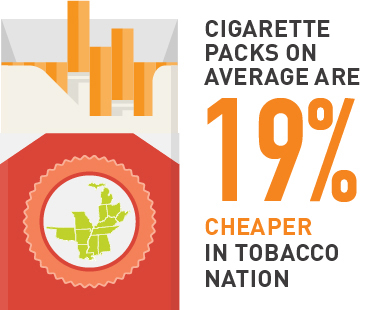
Tobacco Control Policies
When it comes to reducing tobacco use and improving health, tobacco control policies, like regulations and taxes, make a big difference. According to the CDC, “because tobacco control policies take a population-based approach to improving health, policies have the potential to reach groups most affected by tobacco and reduce disparities.” But these policies are largely enacted and enforced at the state and local level, where there is significant variation. Once again, the states within Tobacco Nation operate differently than the average U.S. state—and not for the better.
Taxes
Overall, states within Tobacco Nation have less restrictive tobacco control policies than much of the nation. Cigarette packs, on average, are 19 percent cheaper in Tobacco Nation ($5.48) than in the rest of the U.S. ($6.72). The average excise tax (i.e., targeted tax levied on certain goods like cigarettes) is significantly lower in Tobacco Nation ($.98) than in the rest of the U.S. ($1.89). Evidence indicates that increasing the price of tobacco products can reduce the tobacco-related disparities that exist among different population subgroups. With these cheaper prices and lower taxes, it is little wonder that Tobacco Nation residents continue to smoke at higher rates and tobacco-related disparities persist. Tobacco control policies can make a difference. Research has shown that increasing taxes on cigarettes can result in significantly fewer cigarettes smoked. A 2017 analysis found that tax hikes of $.71 to $4.63 per pack could yield an 8 to 46 percent reduction in cigarette consumption. This is, in part, because price increases, including tax increases, reduce initiation of tobacco use among young people and could make smoking more prohibitive for low-income smokers.
Age Restriction
Restricting the age at which consumers can buy cigarettes is another powerful tool for reducing smoking.
Since the vast majority of smokers begin smoking before the age of 21, Tobacco 21 laws are able to reduce smoking and other tobacco use among young people and have been shown effective, publicly supported and to have minimal, short-term economic impact. A 2015 report by the Institute of Medicine (IOM) committee estimated that if a nationwide Tobacco 21 rule was implemented, it would result in 249,000 fewer premature deaths, 45,000 fewer deaths from lung cancer and 4.2 million fewer lost life-years among Americans born between 2010 and 2019. In New York City alone, after only one year of the Tobacco 21 policy being implemented, past 30-day smoking rates among high school students fell from 8.2 percent in 2013 to 5.8 percent in 2015—a reduction of nearly 30 percent. Unfortunately, with the exception of 23 localities found within Arkansas, Ohio, Missouri, Michigan and Mississippi, no state within Tobacco Nation has opted to take this measure to reduce youth smoking.
Smoke-Free Laws
Smoke-free laws also make a dramatic difference. One national estimate showed that indoor smoking bans, in workplaces alone, would result in 725,000 smokers quitting. The CDC reported that comprehensive smoke-free laws can benefit “people from all socioeconomic, educational and racial/ethnic backgrounds equally by increasing places where people are protected from tobacco smoke.” States like New York, Massachusetts and Illinois, which all have smoke-free bans in workplaces, restaurants, bars and gambling facilities, further illustrate the impact of comprehensive smoke-free laws. In 2002, one year before New York enacted a smoke-free policy, 22 percent of adults were regular smokers. Just two years later, in 2004, adult smoking rates fell to 20 percent. And by 2014, the rate had fallen to just 14 percent, a whopping 35 percent reduction. Massachusetts tells a similar story, with adult smoking rates falling by nearly a quarter from a high of 19 percent in 2004, the year before the law was enacted, to 14 percent in 2010. Next door to Tobacco Nation, in Illinois, lawmakers enacted a smoke-free policy in 2008 and saw a 10 percent reduction from 2007, when smoking prevalence was 20 percent, to 18 percent in 2013.
Unfortunately, only two states in Tobacco Nation (Michigan and Ohio) have laws forbidding smoking in workplaces, restaurants and bars. In the other 38 states, more than half of the states (23) have such comprehensive smoke-free bans in place, which cover 65 percent of their population. Moreover, while the overwhelming majority (85 percent) of the U.S. population not included in Tobacco Nation is protected from smoking in restaurants, just half (50 percent) of Tobacco Nation enjoys this privilege. According to the CDC, secondhand smoke kills roughly 900 infants and 41,000 nonsmoking adults each year.
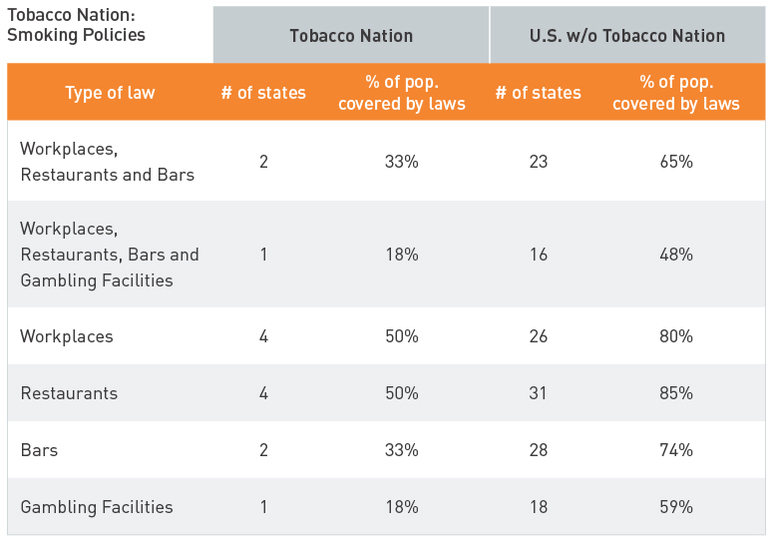
Challenges to Policy Change
Given what we know about their positive impacts, why aren’t smoke-free policies more widely-enacted in Tobacco Nation? A few case examples provide insight into the challenge of changing policies. In Kentucky, for example, no broad restrictions exist to prevent smoking in public places and workplaces, and no major tobacco-control legislation has passed since the 2013-2014 legislative session. A statewide smoking ban to prohibit tobacco use on school properties and at school events has yet to be enacted. Moreover, the tax rate hasn’t changed since 2009. In Missouri, the circumstances are even more bleak; the state has the lowest cigarette excise tax per pack in the nation ($0.17) and the rate hasn’t changed in 24 years.
One factor clearly suppressing the adoption of tobacco control policies in Tobacco Nation is opposition by Big Tobacco. In Louisiana, for example, where cigarette taxes were already among the lowest in the nation, the Governor and legislature kept a 2016 state tobacco tax increase to a mere 22 cents—this following reports of negotiations with industry lobbyists representing a broad range of tobacco interests. And in Missouri, industry giant Reynolds American Inc.*, contributed nearly $13 million in support of a legislative initiative to raise the state’s meager taxes by only 60 cents; research shows that tax increases should be at least $1 to be effective.
It is especially important that states do everything they can to protect their citizens. It is clear that Tobacco Nation is not doing enough. Despite the huge sums of money that states take in as payment from the 1998 Master Settlement Agreement between the major U.S. cigarette companies and the states, states are not spending nearly enough of their tobacco settlement revenues to prevent and reduce tobacco use.
For instance, from 1998 to 2017, Tobacco Nation has received roughly $31.3 billion in payments (as compared to the roughly $112.1 billion the rest of the U.S. has received), providing the unique financial opportunity to fund tobacco prevention and control efforts. Yet, there are hundreds of thousands of preventable deaths attributed to tobacco use every year. With Tobacco Nation not spending enough money on establishing proven policies, regulations and programs that can reduce use and boost public health, the gap between Tobacco Nation and the rest of the U.S. will continue to widen, and the health and economic disparities will continue to deepen.
*As of July 25, 2017, British American Tobacco (BAT) completed the acquisition of Reynolds American Inc (Reynolds), making Reynolds an indirect, wholly owned subsidiary of BAT.
Global Comparison
Tobacco Nation’s low cigarette taxes and lax regulations make it appear notably similar to less-developed countries around the world. And like many developing countries, tobacco use is extremely high.
Smoking prevalence in Tobacco Nation isn’t just high within the U.S. By some measures, it stands alongside the most tobacco-affected countries in the world. According to the Bloomberg Initiative to Reduce Tobacco Use, which focuses on 10 low- and middle-income countries with the greatest number of smokers (China, Indonesia, Vietnam, Philippines, Brazil, Ukraine, Mexico, Bangladesh, Pakistan, India), nearly 80 percent of tobacco users live in low- and middle-income countries. Yet the tobacco prevalence of Tobacco Nation, which resides within a high-income country, makes it more similar to the low- and middle-income nations listed above.
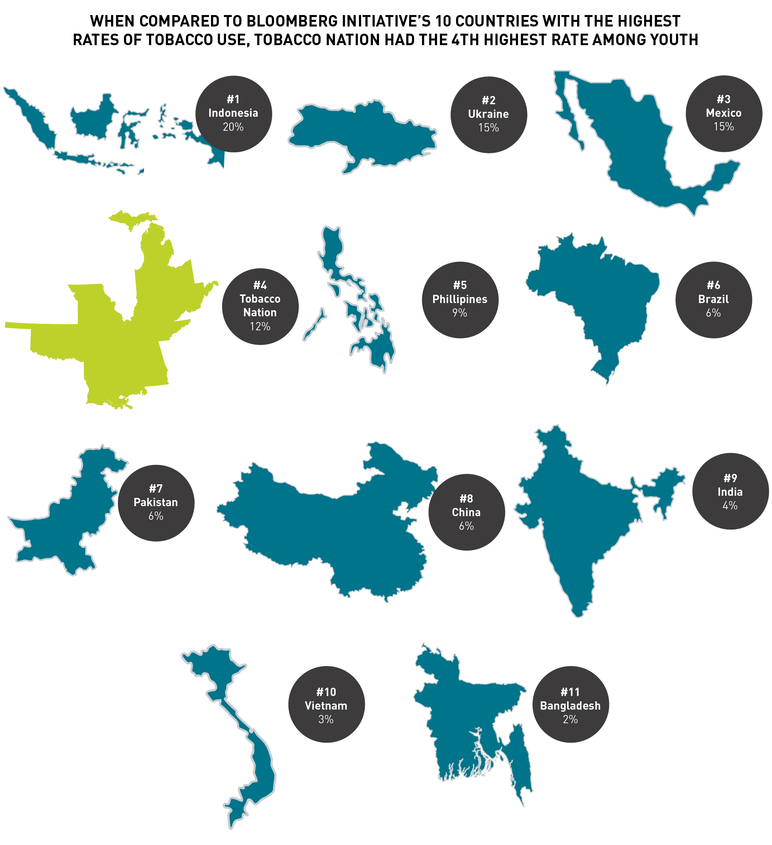
While direct comparisons to other countries are difficult, due to differences in how prevalence rates are measured and reported, it is illustrative to examine Tobacco Nation in light of the highest tobacco-burdened countries worldwide.* When compared to the Bloomberg Initiative’s 10 countries with the highest rates of tobacco use, Tobacco Nation has the fourth-highest rate of youth smoking (12 percent), behind only Indonesia (20 percent), Ukraine (15 percent) and Mexico (15 percent). The Philippines, Brazil, Pakistan, China, India, Vietnam and Bangladesh all had lower youth cigarette smoking rates. Adult smoking prevalence rates are not much better. Tobacco Nation has the fifth-highest rate (22 percent), behind only Indonesia (35 percent), Ukraine (29 percent), China (28 percent) and the Philippines (23 percent). When comparing the U.S. to other countries around the world, it is clear that Tobacco Nation is driving the U.S. smoking rate. When the 12 Tobacco Nation states are removed from the U.S., the remaining 38 states only rank 10th in the Bloomberg comparison.
Unlike the 10 countries of focus in the Bloomberg Initiative to Reduce Tobacco Use, Tobacco Nation enjoys a relatively high income level. Median household income for Tobacco Nation is $45,133, nearly four times as high as Mexico ($11,680), the country included in the Initiative with the second-highest median income. Similarly, per capita gross domestic product (GDP) for Tobacco Nation ($40,854) far outstrips Mexico ($9,005), Brazil ($8,688) and China ($8,069).
While the retail price per pack of cigarettes is highest in Tobacco Nation at $5.48 per pack, the percentage of an average person’s income spent per pack is quite low, when compared to these 10 low- and middle-income countries.† Framing it in this context, cigarette prices in Tobacco Nation are relatively cheap, and Tobacco Nation residents are more financially able to purchase a pack of cigarettes than residents in countries such as India, Indonesia, Brazil and Mexico. The profit margin for cigarettes means that the tobacco industry can afford to sell fewer packs in the U.S., and still come out ahead. British American Tobacco (BAT), home of Reynolds American Inc., “only needs to sell two packs of cigarettes (in the U.S.) to make the same profit as it would selling six in other markets.”
And when it comes to cigarette consumption, price matters. If cigarettes are more affordable for the average Tobacco Nation resident, tobacco usage will continue to be high, and cancer and mortality rates will continue to affect many. Despite its location within a high-income country, the effects of smoking on Tobacco Nation make it clear that the region faces an epidemic that poorer nations are just on the brink of facing.
While the following comparisons are inexact, due to differences in population estimates, they nonetheless paint a discouraging picture.‡
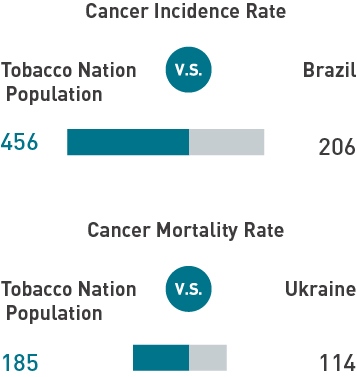
The average cancer rate in Tobacco Nation (456 per 100,000) is more than double that of Brazil (206 per 100,000), the country with the highest incidence rate of cancer among Bloomberg’s countries of focus.
Deaths from cancer are similarly dire in Tobacco Nation, with 185 deaths per 100,000 people, compared to the 114 per 100,000 in Ukraine, which has the highest cancer mortality rate of Bloomberg’s 10 countries of focus. These differences, in rates only, further emphasize the placement of Tobacco Nation within the tobacco epidemic, compared to these other countries. Tobacco Nation should be a cautionary example of how devastating tobacco’s effects can be on health, and lessons should be learned.
The fact that a region within the U.S. can claim such similarities is shocking. In spite of its economic advantages, and despite spending far more money on health care than any country in the world, the U.S. still fails to protect its citizens from so many preventable deaths—a challenge successfully met by numerous other countries.
*Data on prevalence for the 10 countries included in Bloomberg Initiative to Reduce Tobacco Use come from the respective country’s most recent national survey reporting on smoking prevalence, as reported by the World Health Organization. Prevalence rates come from 2008-2015. For youth smoking prevalence, Tobacco Nation data is based on those aged 12-17 whereas the other countries’ data is based on those aged 13-15. For adult smoking prevalence, Tobacco Nation data is based on those aged 18 and older whereas the other countries data is based on those aged 15 and older.
†Data on median household income have been aggregated from 2006-2012. For more details on the methodology for collecting this data please go to: http://www.gallup.com/poll/166211/worldwide-median-household-income-000.aspx. Data on the average retail price per pack (including taxes) are from 2014, and are based on prices of three brands of cigarettes known to be most sold in each country. The average price is weighted by the market share of each of the three brands. The weighted average price is converted from local currency to US dollars using the latest official exchange rates for each country published by the International Monetary Fund.
‡The country rates are from 2012 and are standardized using population estimates from 2012. Tobacco Nation and U.S. rates are from 2013 and are standardized using population estimates from 2000. This could help explain the large numbers for Tobacco Nation and the U.S., and it should be noted that rates would possibly decrease if the 2012 population estimates were used instead.
Call to Action
Despite the success of decades of progress in lowering the smoking rate in the U.S., it is clear that much work remains in the fight against tobacco. We cannot move forward as a country when so many of our states lag far behind. Tobacco Nation’s high smoking rates, along with its relatively poor health outcomes and lack of access to care, make it a disadvantaged country within a country. Were Tobacco Nation its own nation, its profile might place it alongside the most tobacco-affected developing countries in the world.
Ending the fight against tobacco can start with a series of fundamental tobacco control policies. Here is what we know works:
- Higher Taxes: We know that taxes work to discourage tobacco use among lower socioeconomic groups and younger individuals. They can also help to address the price disparity, where current cigarette prices constitute a relatively minor percentage of disposable income compared to cigarette prices around the world.
- Smoke-Free Policies: Everyone deserves clean air. The fact that only two out of the 12 states in Tobacco Nation can guarantee an individual the right to clean air on the job, in a restaurant and at a bar, is woefully behind the times.
- Public Education: Research has consistently demonstrated that tobacco-related public education campaigns save lives, promote quit attempts, reduce youth smoking initiation, lower health costs and blunt the impact of tobacco industry marketing. Effective public education campaigns are adequately funded, guided by scientific research and use of multiple media channels to communicate messages that shift knowledge and attitudes to support policy initiatives designed to reduce tobacco use among a target audience.
- Funding Priorities: The recent significant decline in smoking prevalence in the U.S. has erroneously led many in the general public, as well as those in public and private leadership, to believe tobacco is largely “solved,” or at least “addressed,” in our nation. As a result, both government (local, state and federal) and private funding of tobacco control efforts have languished or re-directed elsewhere. Among private funders, there is a perception that the public sector is adequately dealing with the issue and that the need and opportunity for impact is greater outside the U.S. We must correct this assumption and adequately invest our dollars into programs that work. Investment in tobacco control remains one of the most efficient public health interventions for saving and improving lives. This is even more true for Tobacco Nation, given its disproportionate share of the smoking population.
- Cessation Services: Access to cessation services can dramatically increase the success of quit attempts. States should include the full range of tobacco treatments in their Medicaid policies and provide robust cessation resources their residents.
- Tobacco 21: The national movement to raise the tobacco purchasing age to 21 is beginning to take hold across the country and could be a useful way for Tobacco Nation to address the significantly higher levels of youth smoking.
- Point-of-Sale Policies: Tobacco companies continue to use the retail environment as a way to encourage smoking behavior via product displays and placement, exterior and interior advertisements and promotional and price incentives to consumers. Youth are particularly affected by this type of marketing. State and local governments within Tobacco Nation should enact policies, such as keeping tobacco products behind the counter and tobacco promotional materials above the eye-level of children, to restrict accessibility to children at the point of sale. For examples of other successful state and local efforts to limit tobacco exposure to youth in the retail environment, see our Point-of-Sale Fact Sheet and Policy Resource.
In locations where these types of tobacco control policies have been effectively implemented, tobacco usage rates among both the rich and the poor have lowered. However, these policies have not been consistently and fully adopted and implemented across the country. While further research is needed to ensure that policies reach the most vulnerable among us and lessen the disparities we’ve seen in places like Tobacco Nation, we must try to implement the tools that can make a difference. Unfortunately, residents of Tobacco Nation remain unprotected by fundamental tobacco control measures. It is little wonder then that tobacco companies see dollar signs among the stars and stripes.
The consequences are real. Tobacco Nation’s risk of death and disease exacts too great a cost. According to the CDC, tobacco kills more than half a million people in the U.S., and costs more than $300 billion per year. We as a nation must protect the most vulnerable among us from these harms by reducing smoking rates everywhere, but particularly among the hardest-hit region of Tobacco Nation. No longer can we accept the country within a country phenomenon. We cannot rest until all residents of Tobacco Nation have the same opportunities to live healthy, productive lives.
More in smoking by region
Want support quitting? Join EX Program
By clicking JOIN, you agree to the Terms, Text Message Terms and Privacy Policy.
Msg&Data rates may apply; msgs are automated.



